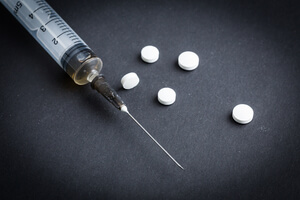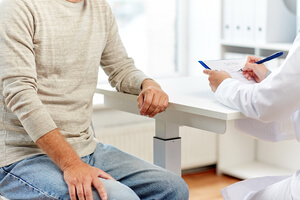How Common Is Relapse?
 Addiction is a chronic disease that involves repeated drug or alcohol use in spite of negative consequences.1 Relapse, or a return to using drugs or alcohol after a period of sobriety is, for many, also a common feature of addiction and recovery. Unfortunately, 40-60% of people recovering from addiction experience a relapse at some point in time.1 Relapse rates for those with substance use disorders are similar to those seen with medical illnesses such as diabetes, high blood pressure, and asthma.1
Addiction is a chronic disease that involves repeated drug or alcohol use in spite of negative consequences.1 Relapse, or a return to using drugs or alcohol after a period of sobriety is, for many, also a common feature of addiction and recovery. Unfortunately, 40-60% of people recovering from addiction experience a relapse at some point in time.1 Relapse rates for those with substance use disorders are similar to those seen with medical illnesses such as diabetes, high blood pressure, and asthma.1
Relapsing after a period of sobriety can be problematic for two major reasons: 1) it can restart the destructive cycle of addiction, and 2) relapsing may more easily lead to an overdose, in some situations. For example, someone who has been sober from opioids such as heroin or painkillers for an appreciable period of time may be more likely to overdose when returning to their usual dose due to the resulting reduction in their tolerance. Essentially, their body is no longer able to handle the amount they’d become accustomed to at the height of their substance use.1 In some situations, such an overdose may be deadly.1,2
Relapses and lapses (a one-time, isolated substance use) are common during recovery and should not necessarily be taken to indicate that treatment has failed or that all recovery progress has been lost. However, because relapse can be so dangerous to a person’s recovery and health, all efforts should be made to prevent it. An intensive outpatient program (IOP) can be a great asset to sustained recovery. This type of program can also serve as a first-line response in the event of a relapse, which often signals a need for new or adjusted treatment measures.1
How Can an IOP Help?
An intensive outpatient program is a form of addiction treatment for people who would benefit from more support than is provided through more standard outpatient therapy but do not require 24-hour inpatient care.3 Someone who is leaving a 24-hour inpatient treatment environment, such as residential rehab, may wish to “step down” to IOP treatment to receive continued intensive support during the day as they make the potentially difficult transition to living at home.

IOP treatment offers a range of services to help address addiction, including:4
- Intensive group and individual therapy sessions where you’ll learn coping skills, practice better ways to communicate and resolve conflict, and gain and awareness of unhealthy thoughts and beliefs (and ways to modify them).
- Medication management, where a doctor evaluates a person and determines whether they would benefit from medications to treat drug and alcohol withdrawal, reduce cravings, or treat other mental health issues. If an IOP is unable to offer these services, a person may be given a referral to another local treatment provider.
- Case management, which can assist with connecting to community resources, such as job training, housing, and healthcare.
- Enhanced services, such as childcare, transportation, housing and meals, parenting education, tobacco cessation treatment, recreational activities, and alternative therapies like mindfulness and acupuncture.
While the exact number of hours of treatment may vary depending upon a person’s needs and the particular program, many intensive outpatient programs provide at least 9 hours of treatment each week spread out over the course of 3 to 5 days.4
The goals of an IOP include:4
- Helping people achieve and maintain abstinence from drugs and alcohol.
- Supporting lifestyle changes that promote abstinence and general well-being.
- Increasing participation in recovery support groups.
- Developing a positive support system.
- Increasing problem-solving and coping skills.
- Helping people address other psychosocial problems, such as unemployment and legal issues.
Relapse prevention is an important component of IOP treatment. Relapse prevention training helps people come up with ways to deal with cravings and triggers without using drugs and alcohol. Intensive outpatient programs teach relapse prevention skills during group and individual therapy sessions. In some instances, IOPs may also prescribe and manage a treatment medication regimen to help alleviate cravings, which can help to prevent a return to compulsive drug use.4
IOPs provide intensive treatment each week and also allow participants the freedom to return home to their responsibilities between sessions. This provides them with an opportunity to encounter the inevitable triggers and other stressful situations in everyday life to better practice relapse prevention and coping skills and then discuss their successes and failures with their counselor.3
In terms of treatment session numbers and weekly time commitments, some IOPs may become gradually less intensive as a person progresses in their recovery.3 Once a person has met their treatment goals in their IOP, they may transition to a relatively lower level of care, such as standard weekly outpatient therapy or counseling.
What to Expect During the Process
Intensive outpatient programs utilize various techniques to help people become sober and maintain that sobriety over time. Treatment programs may provide one or more of the following types of therapies for addictions:4,5
- Twelve-Step Facilitation Therapy introduces people to the 12-step philosophy found in self-help groups like Alcoholics Anonymous and Narcotics Anonymous. This type of treatment offers group therapy sessions that focus on accepting addiction as a disease, surrendering to a higher power (as defined by the individual), and forming relationships with other sober people. IOPs that incorporate this approach may also encourage participants to attend 12-step meetings, read the relevant literature, and work the steps.
- Cognitive Behavioral Therapy, or CBT, helps people learn new ways of thinking and behaving by helping them become more aware of their thoughts, feelings, and actions which, in turn, helps them to identify unhealthy beliefs and devise healthier alternatives. As part of IOP treatment, CBT may also involve the teaching of coping skills to deal with negative emotions and cravings through the use of role-playing, in-session exercises, and homework assignments.
- Motivational Interviewing aims to help people resolve their ambivalence about sobriety and treatment. The MI technique addresses the fact that, very commonly, people who are addicted to drugs and alcohol have mixed feelings about quitting. Counselors work to help people understand how their drug and alcohol use conflicts with their life goals and help them find their own motivation to take positive action. The counselor acts as more of a consultant than a leader, working in partnership with the individual.
A Typical Day in an IOP
A typical day in IOP treatment may include one or more group, individual, and couples or family therapy sessions. Group therapy is a significant component of IOP treatment.
Several different types of group therapy sessions may be offered throughout the week:4
- Psychoeducational groups teach people about addiction and its long-term effects on the brain and body.
- Skills-development groups teach drug refusal, relapse prevention, assertiveness, and stress management skills.
- Support groups allow people in similar stages of recovery to discuss their challenges and learn and practice healthier ways of connecting with others.
- Interpersonal process groups can help people who all share a common experience, such as criminal issues or history of trauma.
- Family and couples’ groups focus on helping the recovering person and their loved ones work through the negative impact of addiction on their relationships.
How Long Does it Last?
The duration of IOP treatment is variable but commonly a program lasts about 90 days.4 Signs of readiness to complete an IOP include:4
- Maintaining sobriety for at least 30 days.
- Completing all treatment goals.
- Regularly participating in a self-help group, such as Alcoholics Anonymous.
- Developing and utilizing a relapse prevention strategy.
- Addressing any foreseeable issues that could contribute to a relapse.
- Residing in a stable, sober environment.
- Maintaining connections with other sober people.
Your Continuum of Care
Continuity of care is important for maintaining sobriety. People who participate in some form of ongoing treatment have better outcomes than those who do not.4 A good aftercare plan may include continued treatment and community support.
Many people continue on with more standard avenues of outpatient care after completion of an IOP. Like IOPs, outpatient treatment for substance abuse recovery is likely to include some combination of individual therapy, psychoeducation, and relapse prevention.4 The difference lies in the intensity of services. You might expect more standard outpatient offerings to consist of treatment sessions in the range of 1 to 2 per week, or scheduled as needed.4 The goals of this level of care include maintaining sobriety, practicing drug refusal skills, connecting with sober people, improving emotional functioning, and resolving lingering issues that might otherwise present challenges to sobriety.4
 Self-help group participation is important both during and after IOP treatment. Recovery self-help groups provide an opportunity to connect with other sober people at various stages of recovery. Twelve-step groups like Alcoholics Anonymous and Narcotics Anonymous help people accept their addictions as a disease, develop a connection with a higher power, and make amends for past wrongdoings. Beyond the 12-step approach, some people find connecting with religious or faith-based organizations to be beneficial. There are also mutual help groups like SMART Recovery that are more secular and science-based if the idea of a “higher power” does not appeal to you.
Self-help group participation is important both during and after IOP treatment. Recovery self-help groups provide an opportunity to connect with other sober people at various stages of recovery. Twelve-step groups like Alcoholics Anonymous and Narcotics Anonymous help people accept their addictions as a disease, develop a connection with a higher power, and make amends for past wrongdoings. Beyond the 12-step approach, some people find connecting with religious or faith-based organizations to be beneficial. There are also mutual help groups like SMART Recovery that are more secular and science-based if the idea of a “higher power” does not appeal to you.
People who have transitioned out of IOP treatment to a lower level of care can benefit from a written relapse prevention plan. Many treatment programs provide education and worksheets on relapse prevention that can continue to be a resource after the program comes to an end. It can also be helpful to regularly update the plan with new information.4
Finding ways to prevent relapse is vital to your health and your recovery. An intensive outpatient program can help you gain the skills needed to stay on a sober path.
Sources:
- National Institute on Drug Abuse. (2018). Drugs, brains, and behavior: The science of addiction.
- Wines Jr, J. D., Saitz, R., Horton, N. J., Lloyd-Travaglini, C., & Samet, J. H. (2007). Overdose after detoxification: A prospective study. Drug and Alcohol Dependence, 89(2-3), 161-169.
- McCarty, D., Braude, L., Lyman, D. R., Dougherty, R. H., Daniels, A. S., Ghose, S. S., & Delphin-Rittmon, M. E. (2014). Substance abuse intensive outpatient programs: Assessing the evidence. Psychiatric Services, 65(6), 718-726.
- Center for Substance Abuse Treatment. (2006). Substance abuse: Clinical issues in intensive outpatient treatment (Treatment Improvement Protocol No. 47). Rockville, MD: Substance Abuse and Mental Health Services Administration.
- National Institute on Drug Abuse. (2018). Principles of drug addiction treatment: A research-based guide.
